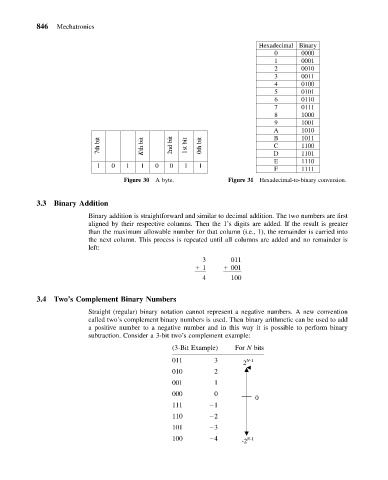Page 855 - Mechanical Engineers' Handbook (Volume 2)
P. 855
846 Mechatronics
Hexadecimal Binary
0 0000
1 0001
2 0010
3 0011
4 0100
5 0101
6 0110
7 0111
8 1000
9 1001
A 1010
B
7th bit Kth bit 2nd bit 1st bit 0th bit D 1011
1100
C
1101
E 1110
1 0 1 1 0 0 1 1
F 1111
Figure 30 A byte. Figure 31 Hexadecimal-to-binary conversion.
3.3 Binary Addition
Binary addition is straightforward and similar to decimal addition. The two numbers are first
aligned by their respective columns. Then the 1’s digits are added. If the result is greater
than the maximum allowable number for that column (i.e., 1), the remainder is carried into
the next column. This process is repeated until all columns are added and no remainder is
left:
3 011
1 001
4 100
3.4 Two’s Complement Binary Numbers
Straight (regular) binary notation cannot represent a negative numbers. A new convention
called two’s complement binary numbers is used. Then binary arithmetic can be used to add
a positive number to a negative number and in this way it is possible to perform binary
subtraction. Consider a 3-bit two’s complement example:
(3-Bit Example) For N bits
011 3 2 N-1
010 2
001 1
000 0
0
111 1
110 2
101 3
100 4 -2 N-1

